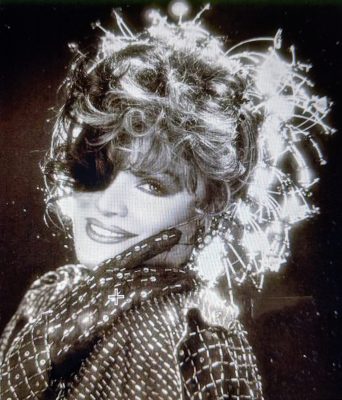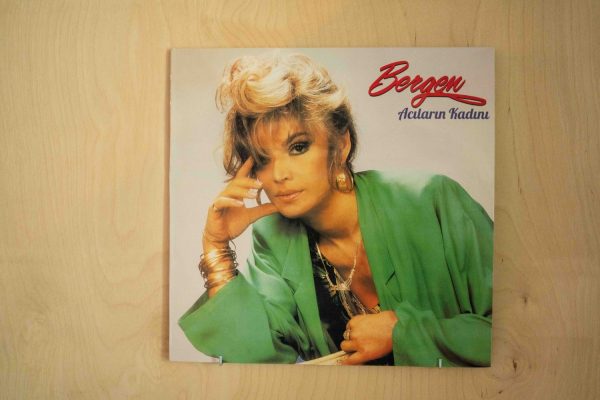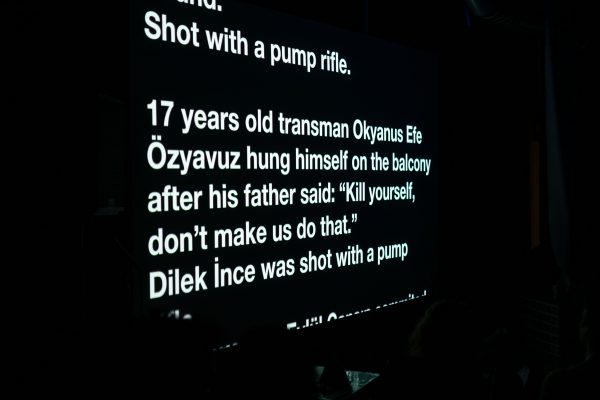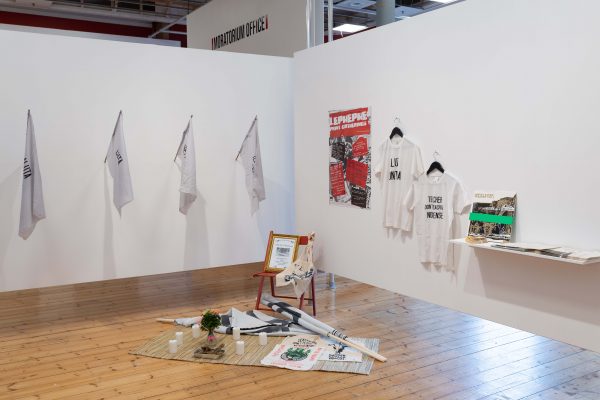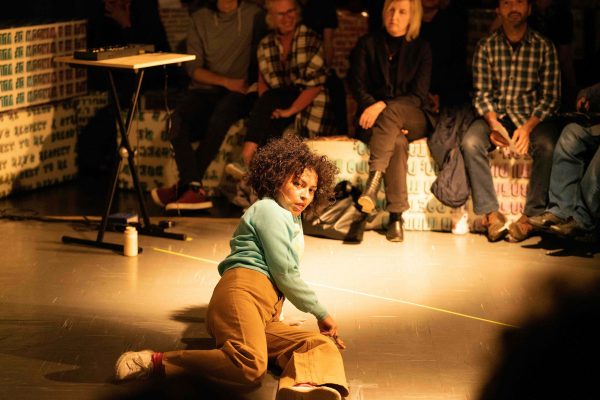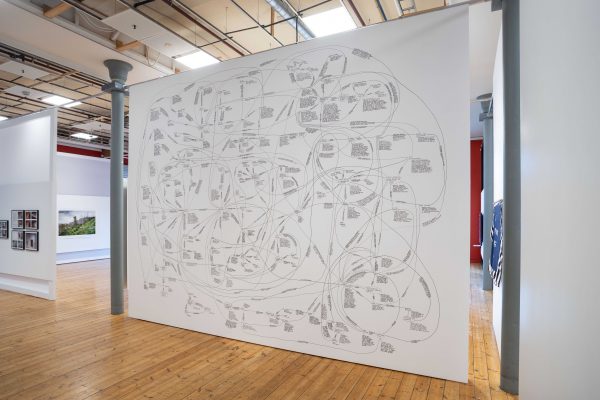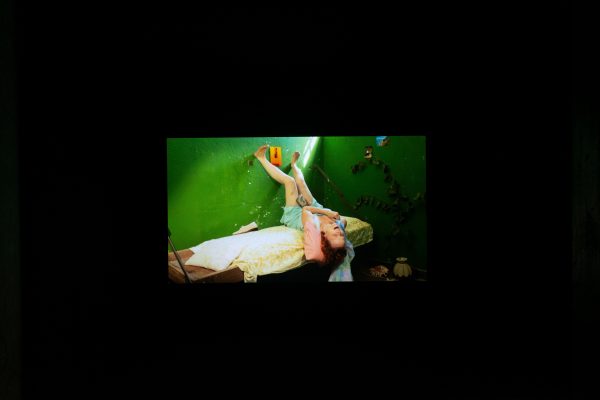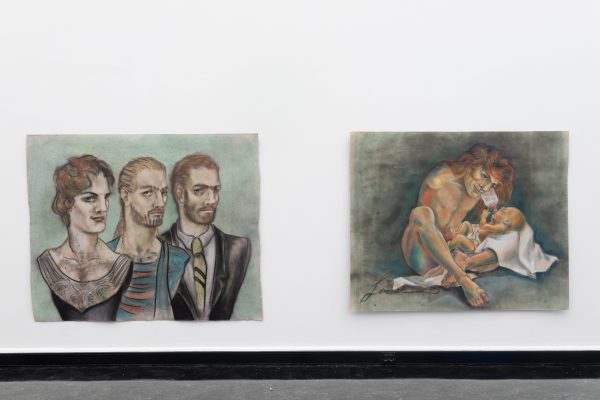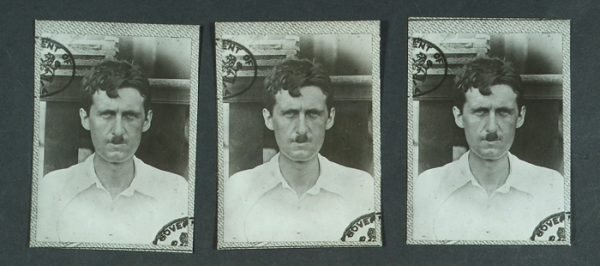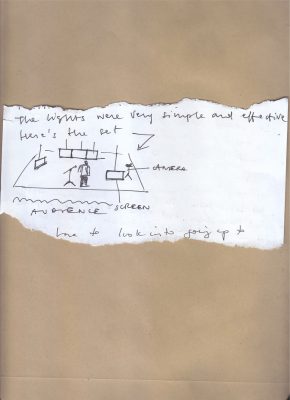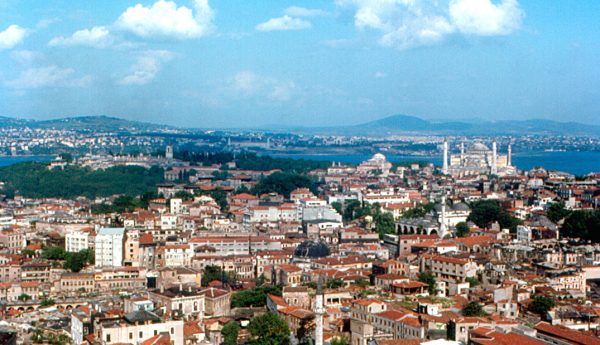During Bergen Assembly’s opening days, I am asked to attend a number of mock funerals, including one for a Turkish pop star. Belgin Sarılmışer was a singer who rose to fame in the 1980s with her album Woman of Agonies, which fused Turkish classical music with kitschy Egyptian love songs, flamenco, folk and rock. Album-cover portraits of Belgin show her in glitzy jewellery and shoulder pads, a cascade of blonde hair falling across her face. By the time she appeared on Turkish television in 1985, she had only one eye. Her husband had thrown nitric acid on her face while she performed, but after surgery she continued to tour, blonde curls styled over the empty socket.
Belgin is best known by her stage name, Bergen, which she chose after seeing a postcard of the Norwegian city, so the story goes. This auspicious concurrence made her a sigil for the 2019 Bergen Assembly, Actually, the Dead are Not Dead, a triennial curated by twelve researchers, activists and artists that unfolded in venues around the city. This year’s event is theory boot camp. In a venue named after Belgin for the duration of the Assembly, the curators introduce the concept of ‘necropolitics’, which has been used to frame the work of the 140 artists included in the triennial. Judith Butler’s famously dense treatise Frames of War (2015) — a text which examines the power wielded by states and sovereigns to decide who is entitled to live and who must die— is invoked as a guide to the politics of death. But, in order to understand necropolitics, it’s necessary to trace it back a little further, to Giorgio Agamben and his complications of the categories of ‘life’ in Homo Sacer (1995). Agamben differentiates between ‘bare’ life, or life as a biological fact with no rights or guarantees, and political life, life qualified by the conditions and/or privileges of each citizen. The current school of necropolitics draws on Agamben’s differentiations to further examine the categories of life, and the slippery border between life and death, human and inhuman. Slavery is a principal focus; in his foundational essay Necropolitics (2003), the Cameroonian theorist Achille Mbembe looks at the right to kill in the colony, interrogating ‘the slave condition’, a form of subjugation that effectively reduces life to a living death.
Written a decade after Mbembe, Butler’s Frames of War surveys the aftermaths of the Iraq War and the so-called ‘war on terror’. It builds on Butler’s earlier thinking in Precarious Life (2003), another set of essays responding to 9/11 and the drastic loss of queer life during the AIDS crisis. It is these essays that Bergen Assembly seems to mine, texts in which Butler examines the politics of mourning and the various public devices – among them funerals, obituaries, and memorials – that assign value to the dead, and through which hierarchies of grief are established. It’s important to note Butler’s distinction between mourning – something public, culturally specific, potentially malleable – and grief, as something private and precious. There is no life without grief, Butler argues. We cannot escape it: if we love and desire, we are bound to suffer some point. Grief is inextricable from life, which means that grief informs life – it constructs the human, and can also violently exclude it. ‘The human is not a universal condition,’ Butler writes, ‘it is a category, and we decide who counts as part of it and who doesn’t. One way we know who counts as human is whether we grieve them when they die.’ This contrast, between lives that ‘count’ and lives that don’t, introduces the concepts of grievability and ungrievability (further outlined in Frames of War). In antithesis to those lives which are mourned, and mourned publicly – all those funerals, obituaries, memorials – stand those which are not. ‘An ungrievable life is one that cannot be mourned because it has never lived, that is, it has never counted as a life at all.’
This last statement of Butler’s – that ungrievable lives are not really lives at all – is used by Assembly curators as a kind of magic formula in reverse. If ungrievable lives are not fully ‘human’ in the first place, then to grieve is to rehumanise, the logic goes. In this way, to grieve is to resuscitate, to bestow the kiss of life, to raise the dead – conceptually, anyway – and to implement the triennial’s title. ‘At this Bergen Assembly we will communicate with the spectres of the past and take responsibility for those who are no longer here,’ explains Iris Dressler, an Assembly curator. ‘We will learn that the living are not merely living and the dead are not merely dead.’ From the get-go, it’s a difficult venture, not to mention an ethical quagmire – cherry-picking Butler along the muddy banks of the Styx. Who, from the swathes of ungrieved dead, gets to be resuscitated? Do the dead even want to be raised? And who has the right to reanimate who?
*
The Assembly curators have several tactics to humanise the dead through grieving. One is to stage funerals. Belgin was murdered by her husband in 1989. One afternoon, the performers Göksu Kunak and Laure M. Hiendl pour a jug of water, symbolising nitric acid, over a black bodybag while reading Belgin’s autopsy (she was shot five times). It’s difficult to watch and, sitting in the audience, I am unsure whether re-staging this violence amounts to solidarity through grieving, or whether it further dehumanises the singer. In a sense, Belgin is attacked by acid all over again. Another funeral takes a more tender approach to its subject. In her performance ‘Album’ (2019), the choreographer Mariana Valencia summons the ghost of Assotto Saint, a Haitian-born poet and activist who died of AIDS in 1994. Valencia invites him onto the stage, sings love songs, and shares ancestral stories from her Latin community, also affected by the epidemic.
Remembrances are not limited to individual lives, but also extend to collectives. In the salons of KODE 1, a decorative art museum in the city’s central square, I attend a funeral for Title in Transgression, a South African artist collective, protest group and support system that existed from 2016–2018. During this period, Simnikiwe Buhlungu and Malebona Maphutse, who led the funeral in Bergen, joined street protests in Johannesburg as part of the wider movement to decolonise educational institutions in South Africa, Rhodes Must Fall. ‘We are taught the Italian renaissance in art schools, but we don’t learn about our own black African history, and it’s frustrating,’ explains Maphutse. The seven members of Title in Transgression made T-shirts for protests with slogans like ‘Teacher don’t teach me nonsense’, some of which are memorialised with candles and petals on the floor of KODE 1. The collective disbanded in 2018. ‘It’s heavy to put your body on the line time and time again, and at some point we realised our collective could no longer be physical,’ says Buhlungu. ‘Now we are thinking about how to mourn and make space for a collective that has ceased to exist. And how do we find new life, or new ways to protest, in this moment of mourning?’
The body count – a figure historically used to assess the success or failure of military combat – is another measure explored by the curators for humanising the dead. As the Assembly opens, the organisers read an urgent dispatch from Colombia, emailed days before by the collective Más Voces, who are also flown over to give a presentation. Two members of the collective list the political murders which have occurred in Colombia since the 2016 peace agreement, of which Norway acted as an international guarantor. In the same room, a stack of newspapers titled The List are dealt out, a collaboration between a Norwegian daily and a European anti-discrimination network, UNITED for Intercultural Action. It includes an inventory of 36,570 bodies –refugees, asylums seekers and migrants who have lost their lives within the borders of Europe since 1993. Soon afterwards, members of Workers’ Families Seeking Justice (WFSJ) screen a documentary about their collective, which has been recording deaths in preventable work-related accidents in Turkey since 2008.
For those involved in conflicts or struggles for justice marked by disappearances and death, it is important to speak, to grieve and to seek justice. And yet, placing death tolls side by side, without clear reasoning, in a small room named after Belgin, is dizzying. With The List in my hands, a WFSJ sticker saying ‘Murder Not Accident’ on my jumper, and the words of Más Voces in my ear, I am left wondering: what connects these killings, which are spread across the globe and brought about by different inequalities and conflicts? How is this data being mobilised? Does simply counting a life make that life count? Perhaps to humanise the dead, to give the dead life as the Assembly proposes, requires an act of re-personalisation, whereby data is not homogenised or collapsed together, but instead animated into biography – not an autopsy, nor numbers, but an obituary.
*
Bergen, a city of wooden houses and medieval spires, is encircled by seven mountains. Rose gardens run up steep slopes, and the smell of cinnamon buns wafts from vintage tearooms. It’s an incongruous place to contemplate Mbembe’s theory of necropower – the tools used to implement slavery, to turn bodies into commodities, a condition that results in ‘an expulsion from humanity altogether…. a form of death-in-life’. Norway, a kingdom formed in 1905, appears to imagine itself free of historical guilt, a twentieth-century nation of peace mediators and donors. As the former prime minister Gro Harlem Brundtland once said: ‘It’s typically Norwegian to be good.’
A work by Finnish artist Minna Henriksson exhibits a history that institutions in the region would rather forget. Her wall drawing ‘Nordic Race Science’ (2016) maps the pseudo-science that flourished in Scandinavia in the 1880s and up to 1945. Once generously state-funded, Race Science became unfashionable after its association with the atrocities of Nazism, and collections of bones and charts were hidden away as a result –suddenly considered to be embarrassing, if not downright incriminating. ‘These collections are only now being uncovered,’ Henriksson explains. ‘Institutions like the Sweden History Museum, who have an extensive skull collection, or the University of Oslo Museum, just wish these artefacts would disappear.’ Currently, these collections remain in the basement of such museums, with their curators in a double bind. On the one hand, they have no desire to promote or showcase such shameful artefacts; and yet to hide or dispose of such artefacts becomes an act of denial. Should they remain in archives and serve as cautionary reminders of a violent ideological ‘science’? Or should these bones be buried, returned to the earth, declassified as artefacts and attended to as skulls? Belgin’s bodybag was a visual exhumation that, unexpectedly, evoked the value of its opposite: the importance of burying, of laying to rest.
*
On the third day I attend The Parliament of Bodies, a ten-hour programme of performances, screenings and lectures, curated by Paul B. Preciado, which extends late into the night. Here, Preciado makes clear that it’s not only necropolitics through which the triennial has been conceived, but also ‘Crip’ theory, a branch of disability studies reclaiming the word ‘cripple’, and which regards disability as something produced by society, rather than by a person’s functional difference. Early in the Parliament, the Spanish disability rights activist Antonio Centeno gave a presentation that eloquently moved the conversation from death towards desire. Centeno suggested that undesirability, like ungrievability, makes a life unlived, and not a life at all. ‘We have been infantilised and asexualised, relegated to a small section of society reserved where we are “tolerated”’, he said of ‘Crip’ bodies. ‘It is essential to build an erotics of dignity. What is the point of putting ramps into nightclubs if there is nobody for us to dance with? We know that nothing but desire is enough.’ Centeno’s documentary, Yes, We Fuck! (2015), follows the sex lives of six functionally diverse people, using footage of group lovemaking and home sex tapes to show how elitist representations of sex usually are.
In bringing together necropolitics and Crip theory, the curators connect the question of who counts as a life worth grieving with another question: who counts as a body worth desiring. This lies at the heart of Pauline Curnier Jardin’s film Qu’un sang impur [Only impure blood] (2019), titled after a colonial lyric from the French national anthem. Echoing scenes in Jean Genet’s homoerotic memoir The Thief’s Journal (1949), Qu’un sang impur opens in a prison where bored, horny guards peep into cells and watch prisoners masturbate. But instead of Genet’s fantasy of cis-male criminals parading stiff cocks, here are menopausal women self-pleasuring in their beds, or women without arms sensually rubbing their bodies against the flaking prison walls. The film is a brazen and lustful depiction of sexuality beyond the pornified, young and able bodies that are otherwise culturally dominant.
Some works transcend the politics by which they are framed. Until I see La Chana dance, I have not understood flamenco. I watch her in a pixellated video clip, part of a small archive compiled by Pedro G. Romero and Maria Garcia on occasions where ‘Crip’ politics and flamenco meet. A self-taught dancer and gypsy, La Chana rose to fame in the 1960s but then vanished from the public eye when her husband forced her off stage. But unlike Belgin, La Chana escaped domestic violence two decades later – running away with her jewels, his money and a BMW, and eventually returning to the stage. Arthritis made it impossible for her to perform upright, so La Chana did so from a chair, as she does in this spellbinding clip – tapping a hypnotic rhythm with her feet, between claps and cries, raising her arms, her shawl, like a great bird – a body at once stationary and in flight.
*
All art is a kind of haunting, carrying the echoes of works that came before; from this view, Bergen Assembly can be seen as a haunted house assembled by twelve curators and inhabited by 140 artists and innumerable ghosts. To walk around it is to find acts of mourning that are both sinister and kind; it is to grieve and get lost, and to rethink what counts as a living, desirable body. At its best, the Assembly asks its audience to pay attention, to look again, and to look better; actually the dead are dead, but that doesn’t stop dead artists speaking, via their artworks, into the present. Preciado opened the Parliament of Bodies by forming a society, The Society of Friends of Lorenza Böttner, to commemorate the Chilean-born dancer and painter who died in 1994. Until very recently, her work was hardly known. Following a small display of Böttner’s work at documenta 14 (2017), curated by Preciado, a solo exhibition opened this February at Württembergische Kunstverein museum in Stuttgart, where Assembly curator Iris Dressler is director. At the Bergen Parliament, Böttner’s mother is in the audience, and she steps forward to shake the hands of a number of curators and artists who have helped to bring her daughter’s work to light.
Seven of Böttner’s drawings are on show next door in Bergen Kunsthall, a set of self-portraits in which she inhabits different bodies and guises, sometimes drawing herself parading a muscled torso, at others in a flamenco dress, her back arched to show off a minuscule pencil waist. Assigned male at birth, she changed her name to Lorenza in the 1970s. In another portrait, ‘Untitled’ (1985), drawn in peach and pastel green, she becomes a mother, holding a bottle at her neck and feeding an infant in her lap. Böttner had no arms, and she drew using her feet and mouth – rejecting prosthesis, and choosing to celebrate, sexualise and transform the body that was her own.
Not all dead artists have a Society of Friends tasked with invigorating their death and haunting the present with their oeuvre. But if anything charges friends to do so, it is grief. ‘Let’s face it. We’re undone by each other,’ writes Butler. And it’s this undoing, this grief, which is a resource, a point of identification, a bird in flight.
share
ABOUT THE CONTRIBUTOR
IZABELLA SCOTT is an editor at The White Review.
